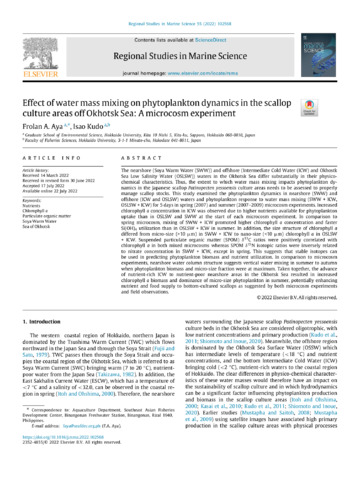Effect of water mass mixing on phytoplankton dynamics in the scallop culture areas off Okhotsk Sea: A microcosm experiment
- Global styles
- MLA
- Vancouver
- Elsevier - Harvard
- APA
- Help

閲覧/開く
日付
2022-09Page views
439ASFA keyword
AGROVOC keyword
Taxonomic term
Geographic names
Metadata
アイテムの詳細レコードを表示する
Share
抄録
The nearshore (Soya Warm Water (SWW)) and offshore (Intermediate Cold Water (ICW) and Okhostk Sea Low Salinity Water (OSLSW)) waters in the Okhotsk Sea differ substantially in their physico-chemical characteristics. Thus, the extent to which water mass mixing impacts phytoplankton dynamics in the Japanese scallop Patinopecten yessoensis culture areas needs to be assessed to properly manage scallop stocks. This study examined the phytoplankton dynamics in nearshore (SWW) and offshore (ICW and OSLSW) waters and phytoplankton response to water mass mixing (SWW + ICW, OSLSW + ICW) for 5 days in spring (2007) and summer (2007–2009) microcosm experiments. Increased chlorophyll a concentration in ICW was observed due to higher nutrients available for phytoplankton uptake than in OSLSW and SWW at the start of each microcosm experiment. In comparison to spring microcosm, mixing of SWW + ICW promoted higher chlorophyll a concentration and faster Si(OH)4 utilization than in OSLSW + ICW in summer. In addition, the size structure of chlorophyll a differed from micro-size (>) in SWW + ICW to nano-size (<) chlorophyll a in OSLSW + ICW. Suspended particulate organic matter (SPOM) \(\mathsf{\delta^{13}C}\) ratios were positively correlated with chlorophyll a in both mixed microcosms whereas SPOM \(\mathsf{\delta^{15}N}\) isotopic ratios were inversely related to nitrate concentration in SWW + ICW, except in spring. This suggests that stable isotopes can be used in predicting phytoplankton biomass and nutrient utilization. In comparison to microcosm experiments, nearshore water column structure suggests vertical water mixing in summer to autumn when phytoplankton biomass and micro-size fraction were at maximum. Taken together, the advance of nutrient-rich ICW to nutrient-poor nearshore areas in the Okhotsk Sea resulted in increased chlorophyll a biomass and dominance of micro-size phytoplankton in summer, potentially enhancing nutrient and food supply to bottom-cultured scallops as suggested by both microcosm experiments and field observations.
Suggested Citation
Aya, F., & Kudo, I. (2022). Effect of water mass mixing on phytoplankton dynamics in the scallop culture areas off Okhotsk Sea: A microcosm experiment. Regional Studies in Marine Science , 55, 102568. https://doi.org/10.1016/j.rsma.2022.102568
Type
ArticleISSN
2352-4855Collections
- Journal Articles [1258]
Related items
Showing items related by title, author, creator and subject.
-
Seasonal growth, organ indices and food consumption of the Japanese scallop Patinopecten yessoensis (Jay, 1857) in relation to food availability in Tokoro seabed, Okhotsk Sea, North Japan
Aya, Frolan ; Kudo, Isao
; Kudo, Isao  (The Plankton Society of Japan (The Japanese Association of Benthology), 2022-05-30)
The coastal waters off Tokoro, Okhotsk Sea have been characterized by a substantial decrease in primary production from spring to summer season which will have repercussions on the maintenance of the Japanese scallop ...
(The Plankton Society of Japan (The Japanese Association of Benthology), 2022-05-30)
The coastal waters off Tokoro, Okhotsk Sea have been characterized by a substantial decrease in primary production from spring to summer season which will have repercussions on the maintenance of the Japanese scallop ... -
Ammonia excretion rates of the sea bass, Lates calcarifer, in fresh and sea water
Almendras, Jesus Manolo E. (Society of Israeli Aquaculture and Marine Biotechnology, 1994)The weight-specific ammonia excretion rate of sea bass (Lates calcarifer) fry in fresh water is higher than that of those in sea water. The allometric equation \(y = 24.426 \times ^{-0.4714}\) best describes the relationship ... -
Effects of UV-treated sea water, chlorinated sea water, and formalin-treated copepods on survival and growth of newborn seahorses, Hippocampus comes
Buen-Ursua, Shelah Mae A.; Azuma, Teruo; Recente, Charlemagne P.; Batatin, Ronald E. (Society of Israeli Aquaculture and Marine Biotechnology (SIAMB), 2011)Seed production of the seahorse Hippocampus comes was examined using different types of sea water (UV-treated, chlorinated, sand-filtered), and formalin-treated copepod Pseudodiaptomous sp. as a food organism. Growth and ...






